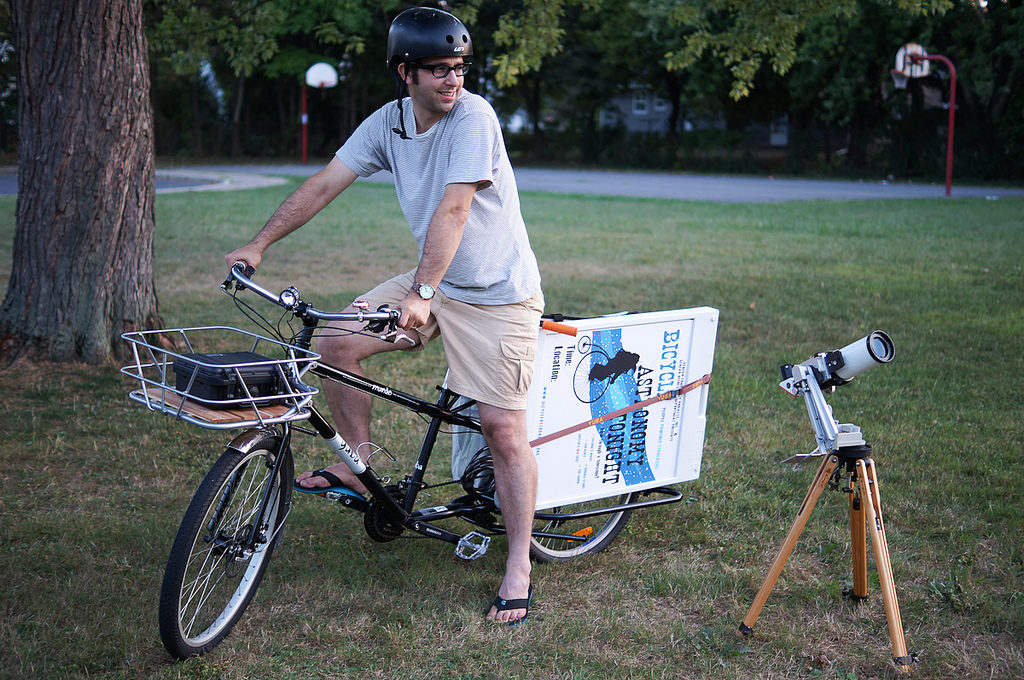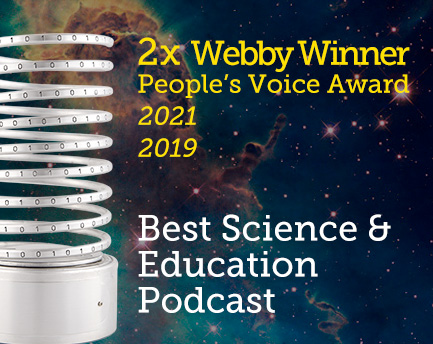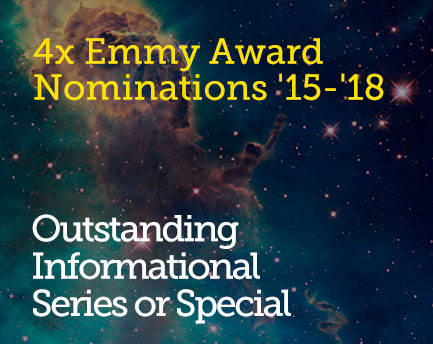June 17, 2015 8:00 pm
Bicycle Astronomy: Cycling to the Stars

Star Party in Geneva, NY. Credit: Brie Plucknette via http://www.gabriellemplucknette.com
Today’s guest blog post comes from amateur bicycle astronomer and Cosmic Community member Doug Reilly. Doug blogs at www.bicycleastronomy.com.
Bicycle Astronomy is the public science outreach project I run in the small city of Geneva, New York. Its mission is to provide every Genevan with an opportunity to experience the wider universe by observing through a telescope, and to demonstrate a sustainable form of transportation by using a cargo bicycle to carry all of my astronomy gear. In this post I want to explain the origins of the project, how it works, and why science outreach efforts like these are so critical.
The idea for Bicycle Astronomy came at a time when I was really grappling with the challenge of climate change and what my own response should be. How small could I make my own “carbon footprint”? Change has to happen individually and locally as well as collectively and globally, and small actions can have huge demonstration effects. So I started riding my bicycle a lot, and it was while cycling that the idea for Bicycle Astronomy came to me. I would literally hitch my oldest passion to my newest; Bicycle Astronomy was my answer to what I think the world needed.
As a child, the telescope provoked me to science and to a deep study of the universe. As an adult, the bicycle came to symbolize a more sustainable way of life. One of the most powerful lessons taught by science in general and astronomy in particular is that our planet is small and fragile and the distances to any new earth, if one exists, are unfathomably far. So in a very real way the telescope inspires the bicycle; even as we push outward into the universe we have to figure out how to sustain life on earth’s thin biosphere.

Doug Reilly on his Yuba Mundo Cargo Bike.
While the bicycle isn’t the only answer to all of our sustainability woes, it does represent a powerful and efficient alternative to the car as a form of local transportation. Some people that might adopt a bicycle, at least part time, wonder how they will carry things around. Astronomy is equipment intensive and thus provides an opportunity to demonstrate a bicycle designed for carrying a lot of cargo. The kind of cargo bicycle I use is called a longtail. It looks like a normal bike but it has an extended rear platform that can hold several riders, or a lot of cargo. My longtail, made by California-based Yuba and fittingly called a Mundo, can carry 440 pounds of cargo! Whether I can pedal that much is the subject of another essay.
During a Bicycle Astronomy star party, while setting up the telescope and waiting for the sky to darken, I talk about the bike and how it helps me to live healthier, cheaper and greener. They can see how much it holds, so when I tell them that I can grocery shop for a family of three, it’s believable. When I talk about the solar system, I give cycling times to various planets; it helps connect the two pieces of the project and also provides people a meaningful way for people to understand the vastness of the universe. For example, at an average city cycling speed of 12 miles per hour, it would take 1,332 years to get to Mars! Competetive cyclists on road bikes could have that time and set up camp for the rest of us.
I am compelled to share the night sky because I think the view of the universe through a telescope, informed by some carefully-chosen contextual information, can be a transformative, even transcendent experience. The night sky provoked me to science as a young person, first on the dome of the Vanderbilt planetarium and then “in person” in the Adirondack mountains. I think that the night sky provoked humanity to science as well. The sky is a device for timekeeping, the calendar, and navigation; people just had to figure out how to decode it. The effort pushed forward our understanding of geometry and math in the process. A more recent example: watching Sputnik crossing the night sky in 1957 provoked a whole generation of astronomers and engineers and provided the human energy for the Space Race.
The ultimate goal of Bicycle Astronomy is to share that provocation with as many people as I can. The benefits of scientific consciousness are neither fanciful nor intangible. Imagine a presidential debate where the audience demands evidence-based reasoning. It would be radically different than anything we have seen! If everyone was science literate, the world would change overnight. We would, for example, accept that anthropogenic climate change is a reality, and start putting our best and brightest minds, and our collective resources, to solving the problem.
As beneficial as it is, communicating astronomy to the public is also deeply fulfilling. Astronomy is a great leveller; generally speaking, most Americans are equally ignorant about the night sky and the universe beyond. In spite of astronomy being one of our earliest and most impactful sciences, it’s not taught in depth. So most people approach the telescope eyepiece with deep curiosity, an open mind, and a willingness to express wonder. Seeing Saturn for the first time usually elicits whoops and wows and quite frequently, profanity. Grown-ups are often more effusive than the children.
Observing the night sky makes for an interesting social activity. It’s often so dark that I have no idea if the person I’m talking to is black or white or brown or yellow, rich or poor, young or old, educated or not. Under the night sky, we are all just humans, humbled by the majesty of the universe, and, I hope for a time at least, connected to each other by a common appreciation of place. It’s a kind of community building.
In contrast to the effusive language above, I don’t preach at the telescope. I let people draw their own meaning from what they see. There is something sacred about their audience with the universe. I do, however, try to provide context. What are they looking at? How big is it? What is it made of and what is it doing? How was it created? How far away is it and how long would it take us to bike there?
I tell stories about the night sky from different cultures. In the summer I love to tell the Japanese story of Tanabata, the star-crossed love of the Shepherd (Altair) and the Weaver (Deneb), separated by the river of the Milky Way by the Weaver’s angry father. I also like to introduce people to the star lore of our continent’s first peoples. For example, I often recount the Navajo story about how First Woman tried to write the laws for her people in the constellations, only to be thwarted by an impatient Coyote, leading to chaos in human history.
Just as those myths are encoded in the constellations, I try to overlay the story of science onto the night sky. I talk about Galileo when I show Jupiter, and how a simple series of observations with a then-novel technology, the telescope, upturned a centuries-old and deeply engrained fallacy. I show people a Cepheid Variable star and contrast its unassuming appearance with its importance in the history of science. I tell people how Henrietta Swan Leavitt, a female astronomer at Harvard in the 1920s, figured out how to use Cepheids to calculate vast distances for the first time. Her work revealed the true scale of the universe; more people may have heard of her if she had not died just as the Swedish Academy of Sciences was nominating her for a Nobel Prize. When people hear stories like these, the night sky becomes not just meaningful, but personal.
Bicycle Astronomy continues. I am currently building a special telescope that folds up into a box that attaches directly to the bicycle. I want to write a guidebook for astronomy outreach that shows people how to not only share the night sky but also teach the scientific method and its history. And some day, I want to run an observatory complex designed to teach observational astromony and planetary science, where people of all ages and all backgrounds can come to learn about the universe, and how to share it with others. This is the work of a lifetime, and I’m lucky to have it.
Get the most out of StarTalk!
Ad-Free Audio Downloads
Priority Cosmic Queries
Patreon Exclusive AMAs
Signed Books from Neil
Live Streams with Neil
Learn the Meaning of Life
...and much more

 Become a Patron
Become a Patron

